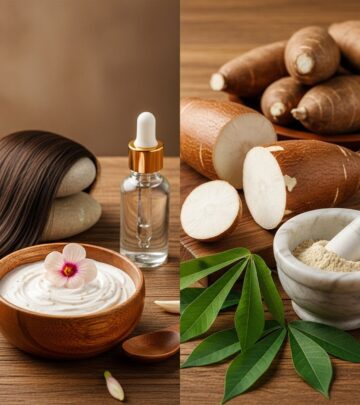Stearyl Glycyrrhetinate: Cosmetic Science, Safety, and Benefits
Discover the composition, uses, safety reviews, and versatility of Stearyl Glycyrrhetinate in cosmetics and personal care products.

Stearyl Glycyrrhetinate
Stearyl Glycyrrhetinate is a widely used ingredient in cosmetics and personal care, valued for its skin conditioning, soothing, and anti-inflammatory properties. Derived from licorice root, this compound is found in formulations for makeup, skin, and hair products. This article explores its chemical background, major functions, regulatory safety, and multifaceted uses in the beauty industry.
What Is Stearyl Glycyrrhetinate?
Stearyl Glycyrrhetinate is an ester formed by combining stearyl alcohol with glycyrrhetinic acid, a bioactive molecule derived from the hydrolysis of glycyrrhizic acid—found in the roots of Glycyrrhiza glabra, commonly known as licorice.
This fine white-to-pale yellowish powder is recognized for its powerful skin-enhancing properties and compatibility with various cosmetic applications.
Related compounds in cosmetic science include glycyrrhetinic acid, glycyrrhizic acid, their respective salts, and esters with similar soothing and protective benefits.
Related Glycyrrhetinic Acid Derivatives in Cosmetics
| INCI/Ingredient Name | Type | Source/Notes |
|---|---|---|
| Glycyrrhetinic Acid | Acid | Extracted from licorice root |
| Stearyl Glycyrrhetinate | Ester | Stearyl alcohol + Glycyrrhetinic acid |
| Potassium Glycyrrhetinate | Salt | Potassium salt of glycyrrhetinic acid |
| Dipotassium Glycyrrhizate | Salt | Potassium salt of glycyrrhizic acid |
| Glyceryl Glycyrrhetinate | Ester | Glyceryl ester |
How Is Stearyl Glycyrrhetinate Made?
The ingredient is produced by esterification of stearyl alcohol (1-octadecanol) with glycyrrhetinic acid. Glycyrrhetinic acid itself is obtained by hydrolyzing glycyrrhizic acid, a saponin compound abundant in licorice root. The resultant ester form is highly compatible with skin and hair care formulas.
Key Functions in Cosmetics and Personal Care
- Skin Conditioning: It forms a soft, protective film on the skin surface, reducing dryness, flaking, and roughness, leaving skin feeling smooth and supple.
- Soothing Agent: Stearyl Glycyrrhetinate is well known for its potent anti-inflammatory activity, which calms irritation, itching, and redness, particularly in sensitive skin types.
- Moisture Retention: Acts as a mild occlusive, supporting the skin’s natural barrier and protecting against transepidermal water loss (TEWL).
- Emollient and Lubricant: Softens and smooths the skin and hair, assisting in detangling and manageability of hair products.
- Antioxidant Effects: Provides antioxidant defense, helping to shield skin from harmful environmental stressors.
- Flavor and Sensory Enhancer: Adds a pleasant sensory profile and slight sweetness/flavor when used in lip- and oral-care formulations.
Applications in Cosmetic and Personal Care Products
Due to its versatility and safety profile, Stearyl Glycyrrhetinate appears in a wide range of applications:
- Facial creams and lotions – boosts moisture and calms irritation
- Sunscreens and after-sun care – soothes sun-exposed skin
- Whitening and brightening formulations – inhibits melanin formation, providing a mild skin-lightening effect
- Cleansers and toners – comfort for sensitive or dry skin
- Shampoos and conditioners – enhances hydration, anti-itch benefits for scalp care
- Shaving products – reduces irritation from shaving
- Makeup and foundation – provides emollience and texture improvement
- Personal hygiene – soaps, wipes, and intimate washes for added mildness
Benefits of Stearyl Glycyrrhetinate for Skin and Hair
- Soothing Redness and Sensitivity: Particularly beneficial for individuals with redness, sensitivity, or inflammatory skin conditions such as eczema or mild dermatitis.
- Barrier Support: Reinforces the natural skin barrier, aiding in protection against external irritants.
- Anti-inflammatory Activity: Helps calm reactions related to environmental exposure, allergens, or harsh ingredients.
- Hydration: Retains moisture for improved skin comfort and skin texture.
- Lightening and Anti-aging Role: Inhibits excess melanin production for a gentle skin-brightening effect and delays the appearance of age spots and hyperpigmentation.
Skin, Hair, and Other Uses at a Glance
| Product Type | Main Purpose |
|---|---|
| Skin Care (Cream, Lotion) | Conditioning, soothing, hydration, anti-inflammation |
| Hair Care (Shampoo, Conditioner) | Emollient, soothing scalp, moisture retention |
| Sun Care | Redness and irritation relief post sun exposure |
| Whitening/Brightening | Mild melanin inhibition, skin lightening |
| Pharmaceutical Topicals | Managed relief for eczema, psoriasis, and inflammatory conditions |
Scientific Safety and Regulatory Review
Stearyl Glycyrrhetinate and many related glycyrrhetinate derivatives have been extensively reviewed for safety in cosmetic and topical use by the Cosmetic Ingredient Review (CIR) Expert Panel. Their evaluations focused on skin absorption, metabolism, systemic effects, and irritancy/allergenicity.
- Absorption: Studies indicate minimal skin penetration. When absorption does occur, glycyrrhetinic acid derivatives bind to plasma albumin and are predominantly excreted in bile, with low urinary excretion.
- Metabolism: Glycyrrhetinic acid is poorly absorbed through the digestive tract but can be hydrolyzed from glycyrrhizic acid metabolites. Ammonium and potassium salts demonstrate even lower bioavailability.
- Systemic Safety: Moderate chronic or high acute exposure to glycyrrhizic acid and ammonium glycyrrhetinate has been noted to cause transient systemic effects, including altered electrolyte balance, water retention, increased body weight, and rarely muscular issues. These are not typical outcomes of cosmetic use due to much lower exposure.
- Dermatological Tolerance: There is a low risk of skin irritation or sensitization, even on sensitive skin, supporting its wide adoption.
- Regulatory Outlook: Globally, Stearyl Glycyrrhetinate is considered safe for use in cosmetic and personal care products when formulated according to standard industry concentrations.
CIR Panel Safety Verdict
Based on extensive data, Stearyl Glycyrrhetinate and related licorice-derived salts and esters are labeled as safe for use in cosmetic and personal care products under current practices of use and concentration. Caution is advised only for chronic pharmaceutical dosing or ingestion, not topical applications.
Origin and Sourcing
Stearyl Glycyrrhetinate’s key raw material, glycyrrhetinic acid, is derived from the roots of the licorice plant (Glycyrrhiza glabra). Licorice has centuries of history in herbal medicines and traditional remedies for skin inflammation, irritation, and healing. Modern biotechnology and chemical processes now offer both plant, animal, and synthetic origin materials, ensuring a stable global supply.
Plant-Based and Alternative Sourcing
- Traditional extraction from licorice roots
- Biochemical synthesis for sustainability and purity
- Regulatory standards may vary by region, e.g., EU vs. US cosmetics regulations
Key Features and Physical Properties
- Form: white to pale yellow powder
- Solubility: generally insoluble in water, soluble in oils/fats
- Molecular weight: varies depending on stearyl chain length
(average ~4,000 for cosmetic grades) - Odor: virtually odorless
Formulation Considerations
- Recommended use concentrations: typically low, up to 1% depending on application
- Compatibility: Works well with both oil- and cream-based formulas
- Stability: Maintains efficacy in a wide pH range and does not degrade rapidly in normal storage
- Pairings: Often used with other emollients, humectants, and barrier-supporting agents for enhanced effect
Popular Cosmetic Product Types Featuring Stearyl Glycyrrhetinate
- Creams and emulsions (day/night, hands/body/face)
- Serums and fluid-based moisturizers
- Scalp lotions and hair masks
- Sun care and after-sun gels
- Soothing balms and gels for localized irritation
- Anti-aging and brightening treatments
Summary of Advantages in Cosmetic Use
- Non-irritating, safe for frequent application
- Highly versatile in product development
- Broad consumer tolerance, including for sensitive and pediatric skin
- Longstanding use history, drawing on both traditional plant wisdom and modern scientific validation
Stearyl Glycyrrhetinate in Broader Applications
- Pharmaceuticals: Used in topical treatments for eczema, dermatitis, psoriasis due to skin barrier effects and anti-inflammatory prowess
- Food Industry: Utilized as a food additive for flavor and texture enhancement (subject to local approvals)
- Research: Being explored for its potential in new formulations, including drug delivery systems and anticancer applications
Frequently Asked Questions (FAQs)
Q: Is Stearyl Glycyrrhetinate safe for all skin types?
A: Yes, Stearyl Glycyrrhetinate is considered low-risk and suitable for most skin types, including sensitive or reactive skin, when used as directed in cosmetics. It has an established safety profile with minimal irritation risk.
Q: Can Stearyl Glycyrrhetinate lighten skin tone?
A: It offers mild skin lightening by inhibiting melanin synthesis, making it useful in gentle brightening products and discoloration treatments.
Q: Are there any common allergic reactions?
A: Allergic responses are exceedingly rare. However, individuals with licorice sensitivities should consult with a dermatologist before use.
Q: How does Stearyl Glycyrrhetinate compare to other soothing ingredients?
A: Its multi-functional combination of soothing, antioxidant, and barrier-supporting effects makes it uniquely versatile compared to ingredients like panthenol or allantoin.
Q: Where does the ingredient originate?
A: The base compound, glycyrrhetinic acid, is primarily extracted from the roots of the licorice plant, but can also be synthesized for greater purity and consistency.
Q: What concentration is used in skin care products?
A: Concentrations typically range from 0.1% to 1%, depending on the product type and intended function.
Q: Does it have uses outside of beauty products?
A: Yes, it is also used in pharmaceuticals, certain food applications, and ongoing scientific research due to its anti-inflammatory and barrier-supporting properties.
Read full bio of medha deb











